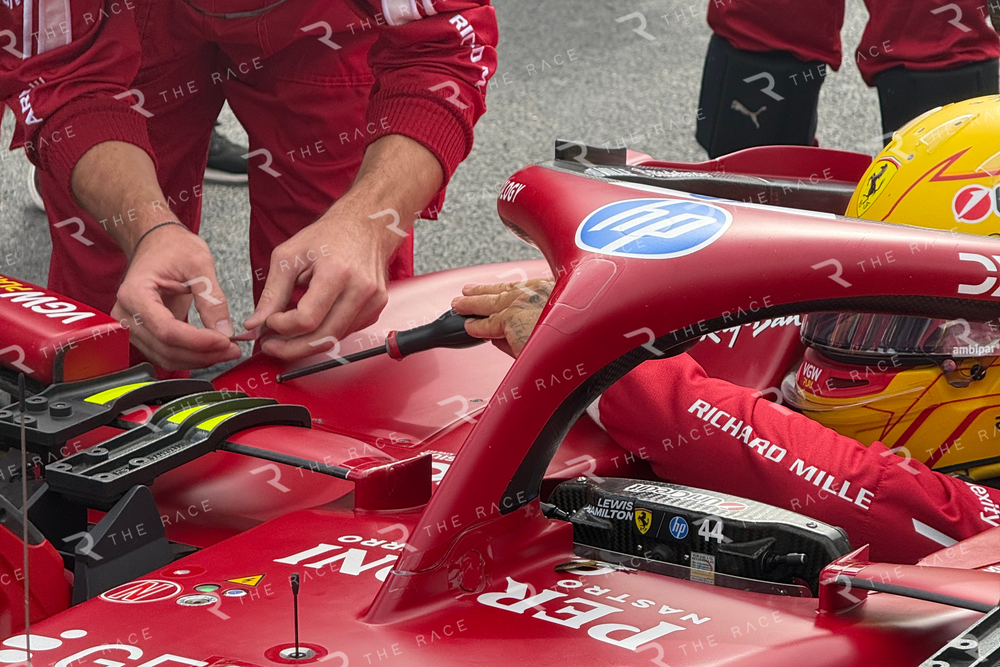Formula 1 operates at the cutting edge of technology, but there are still times where the most basic of solutions to a problem is best.
One example that has come under the spotlight recently relates to race starts and drivers positioning themselves perfectly in their grid spots.
A driver being able to start centimetres forward can be the difference between getting a wheel inside a rival on the run to the first corner or being beaten there themselves.
But there is also the risk element that if they try to push things too far and roll over the front grid box line - as Lando Norris did at this year's Bahrain Grand Prix - then they pick up a penalty.
While some drivers are happy to find their spot unaided, some have adopted alternative solutions to help mark out their perfect stopping spot.
And the different ways that Norris and Lewis Hamilton now attack the same problem highlights how the best answer comes down to personal preference.
Grid rules
From the outside, the task seems quite simple: an F1 driver needs to line up their car within a 2.7-metre-wide grid box as far forward as they are allowed.
The rules allow the nose of their car to be in front of the white box, as being legal is entirely down to the positioning of their wheels.
Article 48.1 of F1's sporting regulations says a driver will be deemed to have made an illegal start if "any part of the contact patch of its front tyres [are] outside of the lines [front and sides] at the time of the start signal".
Being as far forward as you can be seems straightforward, but the reality is that a driver's low seating position in the cockpit, with the halo, extra bodywork and wheel covers all blocking their vision, means they cannot see where their tyres are on the ground.

The FIA paints a yellow guide line towards the front of the grid box, which stretches out across the track and is supposed to help drivers judge where their front wheels need to be.
But that is still not ideal and has not prevented drivers hitting trouble. In 2023, Esteban Ocon and Fernando Alonso picked up penalties early in the season for being out of position in their grid slots.
This triggered a move by the FIA to widen the grid boxes by 20cm.
But as Mercedes driver George Russell explained at the time, it is a very tricky moment for drivers in being able to get their car lined up perfectly - which is why there were some calls at the time for a bit of leniency.
"It's incredibly difficult," reported Russell. "We're sat so low and to put some perspective [on it], we only see probably the top four or five inches of the tyre so you can't actually see the ground itself.
"We've got these big and long yellow lines pointing out. I can't even see the yellow line, let alone the white lines determining your lateral position.
"It’s really, really tough so that's why I think in this regard we need to show a little bit more common sense."
The rules are the rules in terms of where the front wheels need to be, which is why some drivers have elected to employ some personal tricks to help them line-up in the perfect place.
Here we look at the very different ways Hamilton and Norris are attacking the issue in ensuring that they have a visual reference that helps them get their cars in the right spot.
Hamilton's on-car marker

When Hamilton's car is pushed into its grid box, it is then rolled forward by the mechanics under the supervision of his race engineer Riccardo Adami.
Adami keeps a close eye on the positioning of the car so it stops at a point where he thinks it is as far forward as can be.

Once there, Hamilton, with the assistance of a mechanic, has a small piece of black tape put towards the front edge of one of the sidepods.
This will provide a reference point for him to repeat the position of his car when he comes around for the actual start.

At the recent Azerbaijan GP, Hamilton was seen gesticulating with a screwdriver that he had been handed to ensure the marker was in the perfect spot.

The black tape will be lined up to intersect with the yellow line on the grid, so it gives Hamilton the correct reference point for how far forward to pull his car.
Norris's silver tape

Norris approaches the start position headache in a different way: by having his marker attached to a reference point around him rather than on the car. This is normally on the nearest wall.

As the McLaren driver pulls up onto the grid and has his car placed in the right spot by mechanics, race engineer Will Joseph can be spotted in radio conversation with him adjusting the positioning on a long piece of silver tape that he attaches.

Norris will have this tape in line with a fixed point of his car, so when he comes around on the grid he knows how far forward he can go.

Both drivers' solutions may been quite rudimentary compared to the sophistication of most other aspects of their F1 cars, but sometimes teams and drivers do not need to make things any more complicated than is necessary.



